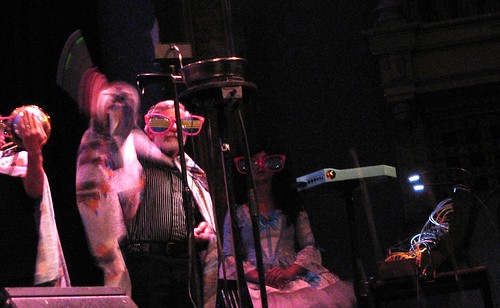 |
| I still have my 1980s Juno 106 with the original "sticker" I put on for live shows. |
In real life sometimes things conspire to change your plans. Sometimes you move ahead despite this. I released my first recording (on cassette tape!) around 1991. I followed in up shortly with a full length album of synthesized sounds, drones, music, and songs. I threw myself into the features and abilities of my synthesizers and effects and completed songs came out based on what I did and what the instrument "gave back" to me. Even though these were machines I felt there was interaction. Modulation settings and envelope decays would continue after I took my hand off the keyboard. I could hit a note and then play another note and the second would interact with the first. For a musician used to piano or reeds this was a new world and I threw myself into it whole heartedly.
Despite playing synthesizers for over 25 years and having my collection and experience grow from one or two 1980s instruments to dozens of vintage and modern pieces including multiple modular synthesizers my approach and fascination to sound and sound sculpture has remained consistent. I try out a tone or note, tweak a few parameters or shift my hand over the keys into a new chord or rhythm, and listen. I build from there repeating the process over and over and eventually I have what I consider a "song". Sometimes it's music in the more traditional sense, other times it's simply a minimal exploration of the evolving nature of sound and it's interaction with me and itself.
I wrote and recorded all my original albums in a third floor walk up one bed room apartment (the original "LegionUK Studios"). I think I originally had one synth (a Yamaha DX27) a peavy keyboard amp with reverb and a Tascam four track. Eventually I got a SCI Pro One and Roland Juno 106 by the time the first full length came out. I called the project "Music For Isolation Tanks" because I felt I was doing this in a vacuum apart from my other experiences. I played bass in a punk band at the time so this was also alien to any musical interaction I had. Halfway through I had to unexpectedly move apartments and I finished the album on the go, hence the title "Exile". It's a minimal exploration of parameters and basic abilities of analog synths chock full of knobs, sliders, and weird low frequencies. As i mentioned before not much has changed.
I took my tweaks on the road playing rock clubs, coffee houses, and art galleries. Anywhere that pretty much seemed inappropriate to be making weird space noises and beats in the early and mid 1990s. Some of these are preserved and now available in lost vault recordings such as
The Caffeine CD:
Or the Studio Live set from 1993:
Most of my free time was spent making music, playing live, sometimes recording those live sets and then playing with other projects, instruments, and bands. I didn't release any full studio recordings of Music For Isolation Tanks music for almost twenty years. But that's only half the story. I continued to experiment, play, jam, and record on my own. Eventually I announced a new albums was "coming soon". About five years later I realized I had amassed enough tracks for exactly that.
Return to Exile is a collection of studio recordings (plus one live track) that I feel capture the original spirit of my curiosity with synthesized sound. It's a retrospective containing all new material. Some tracks go back to about the mid 2000s while the final track was 100% written and recorded in October 2015. It's available to stream in it's entirely for free. promo copies are available for any reviewers. (please email for details).
I'm proud of how these different songs flow. It turns out without even knowing I was putting things together like I always did. And, of course, the machines helped me.
As I used to put on all my old cassette tapes and hand copied Catalogs of mail order items:
"I hope you enjoy this as much as possible" - DT
Return On.




